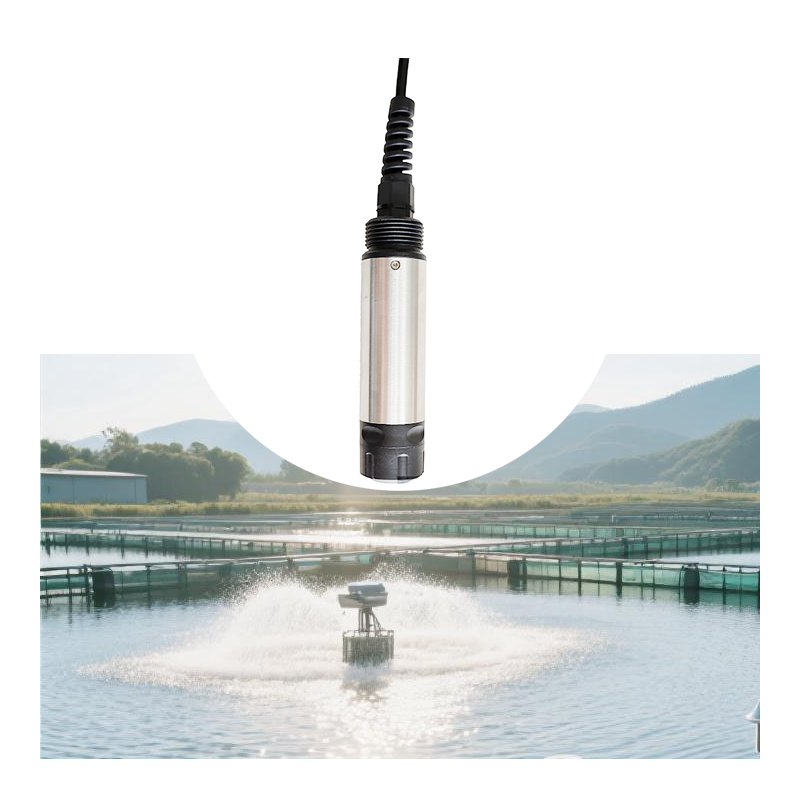The application of water quality dissolved oxygen (DO) sensors is a widespread and successful example of IoT technology in Southeast Asian aquaculture. Dissolved oxygen is one of the most critical water quality parameters, directly impacting the survival rate, growth speed, and health of farmed species.
The following sections detail their application through various case studies and scenarios.
1. Typical Case Analysis: A Large-Scale Shrimp Farm in Vietnam
Background:
Vietnam is one of the largest shrimp exporters in Southeast Asia. A large-scale, intensive vannamei shrimp farm in the Mekong Delta faced high mortality rates due to poor dissolved oxygen management. Traditionally, workers had to manually measure parameters several times a day by boating to each pond, resulting in discontinuous data and an inability to respond promptly to hypoxia caused by nighttime conditions or sudden weather changes.
Solution:
The farm implemented an IoT-based intelligent water quality monitoring system, with the online dissolved oxygen sensor at its core.
- Deployment: One or two DO sensors were installed in each pond, placed at a depth of about 1-1.5 meters (the primary water layer for shrimp activity) using buoys or fixed poles.
- Data Transmission: The sensors transmitted real-time DO data and water temperature to a cloud platform via wireless networks (e.g., LoRaWAN, 4G/5G).
- Smart Control: The system was integrated with the pond’s aerators. Safe thresholds for DO were set (e.g., lower limit: 4 mg/L, upper limit: 7 mg/L).
- Alerts and Management:
- Automatic Control: When DO dropped below 4 mg/L, the system automatically turned on the aerators; when it rose above 7 mg/L, it turned them off, achieving precise aeration and saving electricity costs.
- Remote Alarms: The system sent alerts via SMS or app notifications to the farm manager and technicians if data was abnormal (e.g., consistent decline or sudden drop).
- Data Analysis: The cloud platform recorded historical data, helping to analyze DO patterns (e.g., nightly consumption, changes after feeding) to optimize feeding strategies and management processes.
Results:
- Risk Reduction: Nearly eliminated mass mortality events (“floating”) caused by sudden hypoxia, significantly improving farming success rates.
- Cost Savings: Precision aeration reduced the idle operation time of aerators, saving approximately 30% on electricity bills.
- Improved Efficiency: Managers no longer needed frequent manual checks and could monitor all ponds via their smartphones, greatly enhancing management efficiency.
- Optimized Growth: A stable DO environment promoted uniform shrimp growth, improving final yield and size.
2. Application Scenarios in Other Southeast Asian Countries
- Thailand: Grouper/Seabass Cage Culture
- Challenge: Cage culture in open waters is highly influenced by tides and waves, leading to rapid water quality changes. High-density species like grouper are extremely sensitive to hypoxia.
- Application: Corrosion-resistant DO sensors deployed in the cages provide real-time monitoring. Alerts are triggered if DO drops due to algal blooms or poor water exchange, allowing farmers to activate underwater aerators or relocate cages to avoid significant economic losses.
- Indonesia: Integrated Polyculture Ponds
- Challenge: In polyculture systems (e.g., fish, shrimp, crab), the biological load is high, oxygen consumption is significant, and different species have varying DO requirements.
- Application: Sensors monitor key points, helping farmers understand the oxygen consumption patterns of the entire ecosystem. This leads to more scientific decisions on feeding amounts and aeration times, ensuring a good environment for all species.
- Malaysia: Ornamental Fish Farms
- Challenge: High-value ornamental fish like Arowana and Koi have extremely strict water quality requirements. Slight hypoxia can affect their color and condition, drastically reducing their value.
- Application: High-precision DO sensors are used in small concrete tanks or indoor Recirculating Aquaculture Systems (RAS). These are integrated with pure oxygen injection systems to maintain DO at an optimal and stable level, ensuring the quality and health of the ornamental fish.
3. Summary of Core Value Provided by the Application
| Application Value | Specific Manifestation |
|---|---|
| Risk Warning, Loss Reduction | Real-time monitoring and immediate alarms prevent large-scale hypoxic mortality—the most direct and important value. |
| Energy Saving, Cost Reduction | Enables intelligent control of aeration equipment, avoiding power waste and significantly reducing operational costs. |
| Efficiency Improvement, Scientific Management | Enables remote monitoring, reducing labor; data-driven decisions optimize daily operations like feeding and medication. |
| Increased Yield and Quality | A stable DO environment promotes healthy and rapid growth, improving per-unit yield and product规格 (size/grade). |
| Facilitation of Insurance and Financing | Digital management records provide credible data for farms, making it easier to obtain agricultural insurance and bank loans. |
4. Challenges and Future Trends
Despite widespread application, some challenges remain:
- Initial Investment Cost: A complete IoT system still represents a significant expense for small-scale, individual farmers.
- Sensor Maintenance: Sensors require regular cleaning (to prevent biofouling) and calibration, demanding a certain level of technical skill from users.
- Network Coverage: Network signals can be unstable in some remote farming areas.
Future Trends:
- Declining Sensor Costs and Technology Proliferation: Prices will become more affordable due to technological advances and economies of scale.
- Multi-Parameter Integrated Probes: Integrating sensors for DO, pH, temperature, ammonia, salinity, etc., into a single probe to provide a comprehensive water quality profile.
- AI and Big Data Analytics: Combining artificial intelligence not only to alert but also to predict water quality trends and provide intelligent management advice (e.g., predictive aeration).
- “Sensors-as-a-Service” Model: Emergence of service providers where farmers pay a service fee instead of buying hardware, with the provider handling maintenance and data analysis.
- We can also provide a variety of solutions for
1. Handheld meter for multi-parameter water quality
2. Floating Buoy system for multi-parameter water quality
3. Automatic cleaning brush for multi-parameter water sensor
4. Complete set of servers and software wireless module, supports RS485 GPRS /4g/WIFI/LORA/LORAWAN
For more water sensor information,
please contact Honde Technology Co., LTD.
Email: info@hondetech.com
Company website: www.hondetechco.com
Tel: +86-15210548582
Post time: Sep-25-2025


